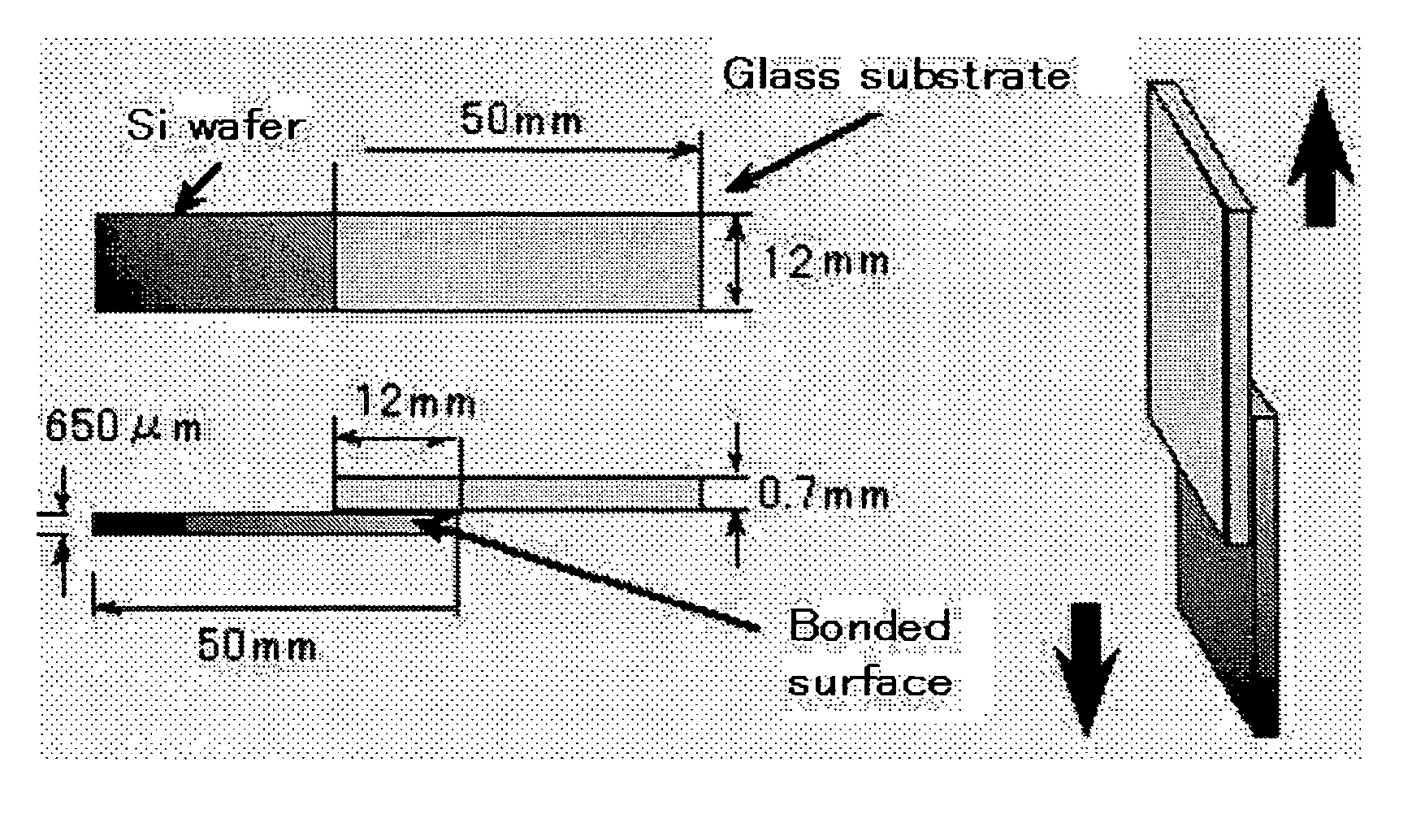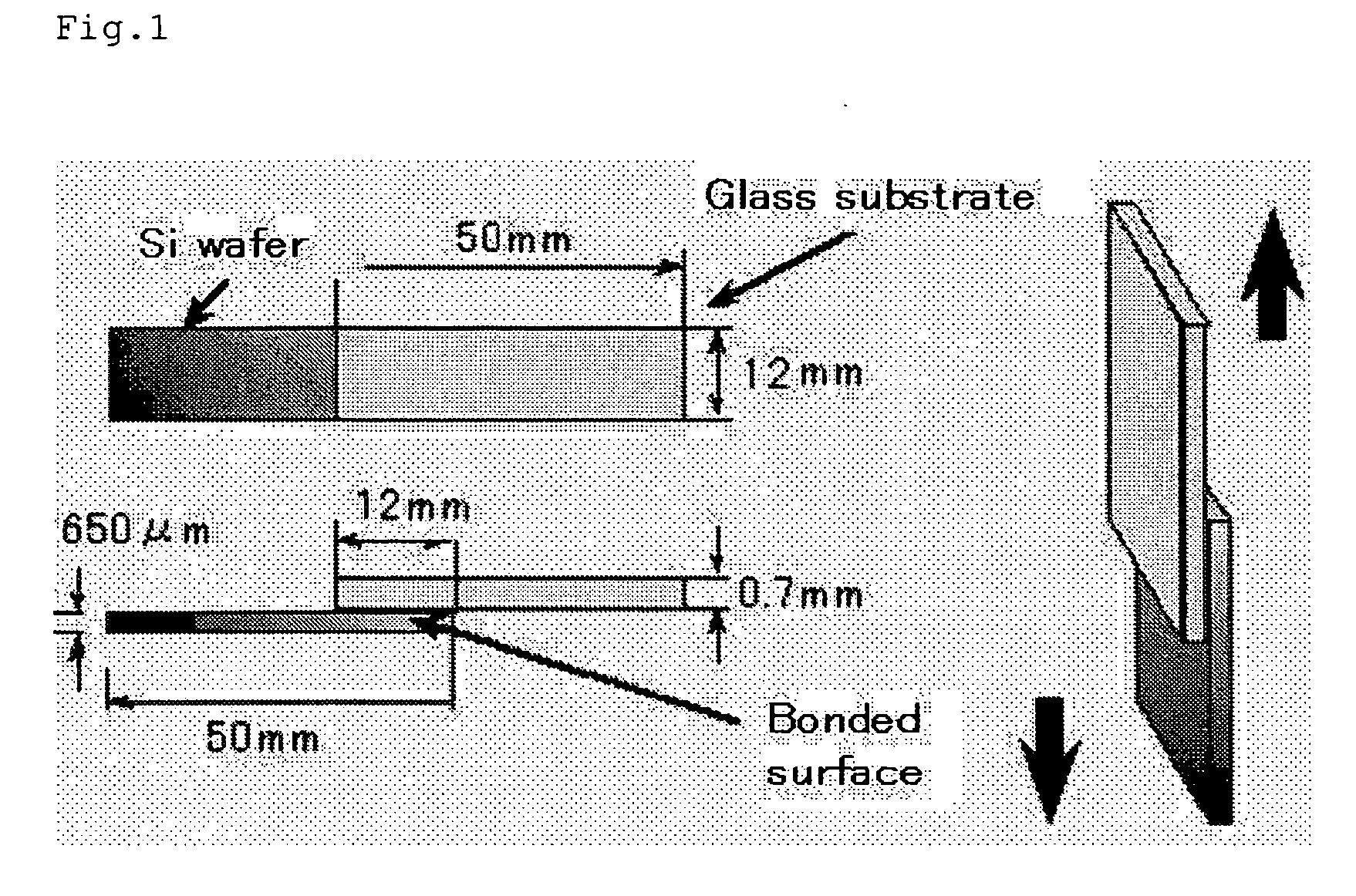Hot melt adhesive composition
a technology of adhesive composition and hot melt, which is applied in the direction of polyether adhesives, non-macromolecular adhesive additives, film/foil adhesives, etc., can solve the problems of low heat resistance, low dispersion accuracy, and prone to breakage of wafers or devices, and achieves easy peeling of semiconductor wafers, easy cleaning or removal, and thin grinding
- Summary
- Abstract
- Description
- Claims
- Application Information
AI Technical Summary
Benefits of technology
Problems solved by technology
Method used
Image
Examples
example 1
[0076] Into a cylindrical pressure molding machine having a diameter of 10 mm, 0.354 g of cholesterol (molecular weight: 386.7, melting temperature: 150° C., melting temperature width: 1° C., melt viscosity: 2 mPa·s) was weighed, and a pressure of 200 kg·cm−2 was applied for 3 minutes to obtain a cylindrical tablet having a diameter of 10 mm and a thickness of 5.5 mm.
[0077] The resulting tablet was placed on a 6-inch silicon wafer (thickness: 650 mm), then a square glass substrate having a thickness of 0.7 mm and a side length of 20 cm was placed on the tablet, and they were placed in a vacuum oven and heated to 150° C. at 10 Torr. As the 6-inch silicon wafer to be bonded, a wafer whose surface had been subjected to hydrophobicity-imparting treatment consisting of spin coating with a 5% isopropyl alcohol solution of hexamethyldisilazane and drying was used. The tablet was melted at a wafer temperature of about 148° C. At this time, vacuum drawing was terminated, and the cholesterol...
example 2
[0080] An aluminum substrate was laminated onto a glass substrate in the same manner as in Example 1, except that a 6-inch aluminum substrate (thickness: 3 mm) whose surface to be laminated had been partially provided with a fine wiring pattern of 10 μmL / S and 5 μm depth was used instead of the 6-inch silicon wafer, a mixture (melting temperature: 157° C., melting temperature width: 1° C., melt viscosity: 1 mPa·s) of 0.5 g of ergosterol (molecular weight: 396.7, melting point: 157° C.), 0.05 g of a surface active agent “SF-8428” (available from Dow Corning Toray Silicon Co., Ltd.) and 0.03 g of silicon dioxide fine particles (available from Shionogi & Co., Ltd., mean particle diameter: 2 μm) was used instead of cholesterol, and the heating temperature of the vacuum oven was changed to 160° C. The bond strength was 4.6 MPa (25° C.), and a difference between the bond strength at 25° C. and the bond strength at 137° C. was 0.2 MPa. The tensile shear strength of the sample (laminate of ...
example 3
[0083] A copper foil (roughened side) was laminated onto a glass substrate in the same manner as in Example 1, except that a square electrodeposited copper foil (thickness: 25 μm) having a side length of 13 cm was used instead of the 6-inch silicon wafer. Then, the shiny side of the copper foil was coated with an insulating film varnish “WPR-1020” (available from JSR Corporation) in a thickness of 2 μm by spin coating, and the varnish was dried at 140° C. for 1 hour to form an insulating film. A dispersion of the thickness of the insulating film was measured. As a result, a mean film thickness was 2.05 μm, and the dispersion was 0.02 μm. This dispersion was equivalent to that in the case of formation of an insulating film on a usual silicon wafer by spin coating, and it was found that lamination between the glass substrate and the copper foil had been uniformly carried out. Further, even in the drying step at 140° C. to form an insulating film, the copper foil did not peel off from ...
PUM
| Property | Measurement | Unit |
|---|---|---|
| melt viscosity | aaaaa | aaaaa |
| melting temperature | aaaaa | aaaaa |
| melting temperature | aaaaa | aaaaa |
Abstract
Description
Claims
Application Information
 Login to View More
Login to View More - R&D
- Intellectual Property
- Life Sciences
- Materials
- Tech Scout
- Unparalleled Data Quality
- Higher Quality Content
- 60% Fewer Hallucinations
Browse by: Latest US Patents, China's latest patents, Technical Efficacy Thesaurus, Application Domain, Technology Topic, Popular Technical Reports.
© 2025 PatSnap. All rights reserved.Legal|Privacy policy|Modern Slavery Act Transparency Statement|Sitemap|About US| Contact US: help@patsnap.com



